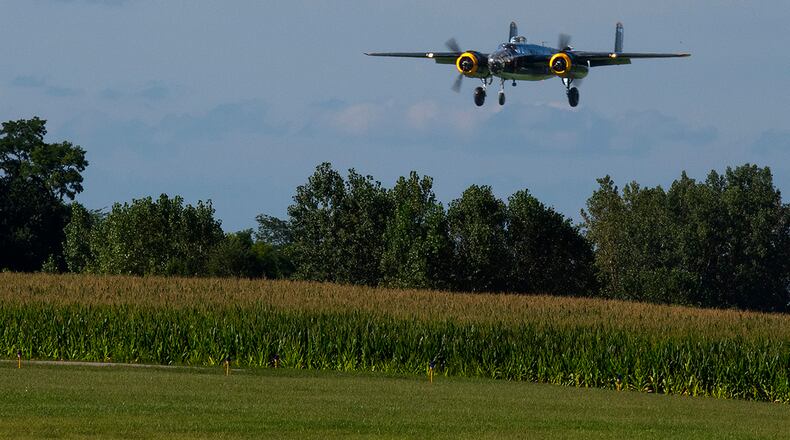“It’s so enjoyable,” Mangold said. “I get to go out and meet veterans, talk to the families of people who maybe their father or someone else had flown the B-25, or at least served in World War II.”
Mangold is among a group of volunteers with the Champaign Aviation Museum in Urbana. They work year-round to keep the bomber, “Champaign Gal,” airworthy and devote time restoring other aircraft, including a B-17, C-47 and Navy C-1.
“When I first moved here in 2015, I heard that they were restoring a B-17. My passion was really to be part of the B-17 restoration process,” Mangold said. “Once I got involved with that, I quickly realized that there was a flyable B-25 in the hangar.”
Mangold remembers how David Shiffer, the museum director, told him a month doesn’t go by that he doesn’t get a call from an airline pilot with thousands of hours volunteering to fly for them.
“He’ll ask them, ‘Well, are you willing to show up on any given Saturday and push a broom around the hangar floor?’ And most of them say ‘no,’ and he’s like, ‘Well, we’re really not interested in you then,’” Mangold said. “You have to be willing to do not just the fun stuff, the flying, you also have to be willing to show up for the safety meetings. You have to be willing to show up on the days that we just do restoration work on the B-25 or B-17, so that you prove your worth to the museum.”
Mangold kept showing up and proving his worth.
“I waited a couple of years for them to get know me and me to get to know them,” Mangold said. “Eventually, when they realized I wasn’t going to go away, they offered to let me join their flight program.”
Flying season is in the summer, but the work is year-round.
In March, Champaign Gal was up on jack stands. Her wheels were off, main mounts in pieces, and her propellors were in Michigan being recertified.
“It’s an ongoing process,” said Dan Dickerson, a volunteer and member of the museum’s board of directors. “It’s an airplane, so there’s always something you have to be working on.”
Mangold said he’s often asked what the hardest part is of flying the B-25. His answer? Getting the engines started.
“It’s not just a turnkey or a push-button,” he said. “You almost have to be an octopus and have like eight hands because there’s levers, switches, different things you have to turn on and off in the right sequence to get the engine to start.”
He finds the actual flying is not hard.
“It flies like an airplane — you know, a little left rudder and the airplane turns left,” he said.
He found there is one difference flying the B-25 compared to a C-130.
“The C-130 has hydraulic assist on all the flight controls,” Mangold said. “The B-25 can be a little bit of a handful. It has no hydraulic assist. So, everything is strength and I think my right arm looks like Popeye because you’re going to manhandle the controls a lot more than what you would in a C-130.”
Those wanting more information on the Champaign Aviation Museum or interested in volunteering can visit its website at www.champaignaviationmuseum.org.
About the Author




